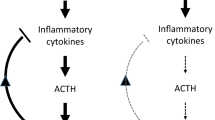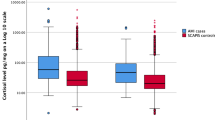Abstract
It is known that low testosterone (T) and high cortisol levels are associated with hypertension as well as with chronic stress, linking stress with elevated blood pressure (BP). However, the association between acute stress-, chronic stress responses and BP is not clear in Africans. Therefore, we examined the association between cortisol, psychological distress and BP responses in low- and high-T male subgroups. Beat-to-beat and ambulatory blood pressure (ABPM) and electrocardiogram measures were obtained. Serum samples were collected and analyzed for sex hormones and cortisol. Chronic psychological distress was verified with the General Health Questionnaire and acute stress with the cold pressor test. More chronic psychological distress was observed in both low- and high-T Africans compared with the Caucasians. The low-T Africans tended to have more ischemic events (P=0.06) and ABPM values (P⩽0.01) than any of the other groups. Both chronic distress (cortisol) and acute stress (total peripheral resistance cold pressor responses) were associated with ABPM in the low-T African group. Acute and chronic stress may contribute to increased BP in low-T African men. Their cortisol and vascular responses supported a tendency for ischemia, increasing their risk for coronary artery disease.
This is a preview of subscription content, access via your institution
Access options
Subscribe to this journal
Receive 12 digital issues and online access to articles
$119.00 per year
only $9.92 per issue
Buy this article
- Purchase on Springer Link
- Instant access to full article PDF
Prices may be subject to local taxes which are calculated during checkout
Similar content being viewed by others
References
Kupelian V, Page ST, Araujo AB, Travison TG, Bremner J, McKinlay JB . Low sex hormone-binding globulin, total testosterone, and symptomatic androgen deficiency are associated with development of the metabolic syndrome in nonobese men. J Clin Endocrin Metab 2006; 91: 843–850.
Akishita M, Hashimoto M, Ohike Y, Ogawa S, Iijima K, Eto M et al. Low testosterone level is an independent determinant of endothelial dysfunction in men. Hypertens Res 2007; 30: 1029–1034.
Malan NT, von Känel R, Schutte AE, Huisman HW, Schutte R, Smith W et al. Testosterone and acute stress are associated with fibrinogen and vonWillebrand factor in Africanmen:The SABPA study. Int J Cardiol 2013; 168 (5): 4638–4642.
Malan NT, Hamer M, Schutte AE, Huisman HW, van Rooyen JM, Schutte R et al. Low testosterone and hyperkinetic blood pressure responses in a cohort of South African men: The SABPA study. Clin Exp Hypertens 2013; 35: 228–235.
Smith GD, Ben-Shlomo Y, Beswick A, Yarnell J, Lightman S, Elwood P . Cortisol, testosterone, and coronary heart disease: Prospective evidence from the Caerphilly study. Circulation 2005; 112: 332–340.
Ezaki K, Nakagawa M, Taniguchi Y, Nagano Y, Teshima Y, Yufu K et al. Gender differences in the ST segment – effect of androgen-deprivation therapy and possible role of testosterone. Circ J 2010; 74: 2448–2454.
Heim CM, Nater UM . Hypercortisolism and stress. In: Fink G, McEwen B, de Kloet R, Rubin R, Chrousos G, Steptoe A, et al. (eds.) Encyclopedia of Stress 2nd Edn Elsevier: Amsterdam, the Netherlands, 2007 pp 400–407.
Whitworth JA, Williamson PM, Mangos G, Kelly JJ . Cardiovascular consequences of cortisol excess. Vasc Health Risk Manag 2005; 1: 291–299.
Esler M, Eikelis N, Schlaich M, Lambert G, Alvarenga M, Dawood T et al. Chronic mental stress is a cause of essential hypertension: presence of biological markers of stress. Clin Exp Pharmacol Physiol 2008; 35: 498–502.
Mansour VM, Wilkinson DJC, Jennings GL, Schwarz RG, Thompson JM, Esler MD . Panic disorder: coronary spasms as a basis for cardiac risk? Med J Aust 1998; 168: 390–392.
Sainani GS, Maru VG . Role of endothelial cell dysfunction in essential hypertension. J Assoc Physicians India 2004; 52: 966–969.
Nabel EG, Ganz P, Gordon JB, Alexander RW, Selwyn AP . Dilation of normal and constriction of atherosclerotic coronary arteries caused by the cold pressor test. Circulation 1988; 77: 43–52.
Kjaer A, Meyer C, Nielsen FS, Parving H-H, Hesse B . Dipyridamole, cold pressor test, and demonstration of endothelial dysfunction: a PET study of myocardial perfusion in diabetes. J Nucl Med 2003; 44: 19–23.
Schwabe L, Haddad L, Schachinger H . HPA axis activation by a socially evaluated cold-pressor test. Psychoneuroendocrinology 2008; 33: 890–895.
Reimann M, Hamer M, Schlaich MP, Malan NT, Ruediger H, Ziemssen T et al. Greater cardiovascular reactivity to a cold stimulus is due to higher cold pain perception in black Africans: the Sympathetic Activity and Ambulatory Blood Pressure in Africans (SABPA) study. J Hypertens 2012; 30: 2416–2424.
Klippel NJ, Heil DP . Validation of energy expenditure prediction algorithms in adults using the Actical electronic activity monitor. Med Sci Sports Exerc 2003; 35: S284.
Jarvis MJ, Tunstall-Pedoe H, Feyerabend C, Vesey C, Saloojee Y . Comparison of tests used to distinguish smokers from nonsmokers. Am J Public Health 1987; 77: 1435–1438.
Hastedt M, Büchner M, Rothe M, Gapert R, Herre S, Krumbiegel F et al. Detecting alcohol abuse: thraditional blood alcohol markers compared to ethyl glucuronide (EtG) and fatty acid ethyl esters (FAEEs) measurement in hair. Forensic Sci Med Pathol 2013; 9 (4): 471–477.
Marfell-Jones M, Olds T, Steward A, Carte JEL In: International Standards for Anthropometric Assessment. ISAK: Lower Hutt, New Zealand, p137, 2006.
Mosteller RD . Simplified calculation of body-surface area. N Eng J Med 1987; 317: 1098.
Kohara K, Nishida W, Maguchi M, Hiwida K . Autonomic nervous function in non-dipper essential hypertensive participants: evaluation by power spectral analysis of heart rate variability. Hypertension 1995; 26: 808.
Mancia G, De Backer G, Dominiczak A, Cifkova R, Fagard R, Germano G et al. Guidelines for the management of arterial hypertension: The Task Force for the Management of Arterial Hypertension of the European Society of Hypertension (ESH) and of the European Society of Cardiology (ESC). J Hypertens 2007; 25: 1105–1187.
Goldberg DP, Gater R, Sartorius TB, Ustun TB, Piccinelli M, Gureje O et al. The validity of two versions of the GHQ in the WHO study of mental illness in general health care. Psychol Med 1997; 27: 191–197.
Wissing MP, Van Eeden C . Empirical clarification of the nature of psychological well-being. S Afr J Psychol 2002; 32: 32–44.
Wesseling KH, Jansen JRC, Settels JJ, Schreuder JJ . Computation of aortic flow from pressure in humans using a non-linear, three-element model. J Appl Physiol 1993; 74: 2566–2573.
Uen S, Fimmers R, Weisser B, Balta O, Nickenig G, Mengden T . ST segment depression in hypertensive patients: a comparison of exercise test versus Holter ECG. Vasc Health Risk Man 2008; 4: 1078–1080.
Wust S, Wolf J, Hellhammer DH, Federenko I, Schommer N, Kirschbaum C . The cortisol awakening response—normal values and confounds. Noise Health 2000; 2: 79–88.
Fahed AC, Gholmieh JM, Azar ST . Connecting the lines between hypogonadism and atherosclerosis. J Endocrinol 2012; 2012: 793953.
Kudielka BM, Kirschbaum C . Sex differences in HPA axis response to stress: a review. Biol Psychol 2005; 69: 113–132.
Malan L, Hamer M, Reimann M, Huisman H, van Rooyen J, Schutte A et al. Defensive coping, urbanization and neuroendocrine function in black Africans: the THUSA study. Psychophysiology 2012; 49: 807–814.
Malan L, Hamer M, Schlaich MP, Lambert G, Ziemssen T, Reimann M et al. Defensive coping facilitates higher blood pressure and early subclinical structural vascular disease via alterations in heart rate variability: the SABPA study. Atherosclerosis 2013; 227: 391–397.
Reimann M, Hamer M, Malan NT, Schlaich MP, Lambert G, Ziemssen T et al. Effects of acute and chronic stress on L-arginine nitric oxide pathways in a bi-ethnic population: the SABPA study. Atherosclerosis 2013; 227: 391–397.
Boyne MS, Woollard A, Phillips DIW, Taylor-Bryan C, Bennett FI, Osmond C et al. The association of hypothalamic-pituitary-adrenal axis and blood pressure in an Afro-Caribbean population. Psychoneuroendocrinology 2009; 34: 736–742.
Esler M, Jennings G, Lambert G . Measurement of overall and cardiac norepinephrine release into plasma during cognitive challenge. Psychoneuroendocrinology 1989; 14: 477–481.
Malan L, Hamer M, Schlaich M, Lambert GW, Harvey BH, Reimann M et al. Facilitated defensive coping, silent ischemia and ECG left ventricular hypertrophy: the SABPA study. J Hypertens 2012; 30: 543–550.
Malan L, Schutte AE, Malan NT, Wissing MP, Vorster HH, Steyn HS et al. Specific coping strategies of Africans during urbanization: comparing cardiovascular responses and perception of health data. Biol Psychol 2006; 72: 305–310.
Acknowledgements
The Sympathetic activity and Ambulatory Blood Pressure in African study is funded by the North-West University, the National Research Foundation (UID 65607), Roche Diagnostics, South Africa, South African Medical Research Council and the Metabolic Syndrome Institute, France. The funders played no role in the design and conduct of the study, collection, management, analysis and interpretation of the data; and preparation, review or approval of the manuscript. The views expressed in this article are those of the authors and not necessarily of the funding bodies.
Author contributions
NTM had full access to the data, takes responsibility for the integrity of the data and accuracy of the data analyses. All authors contributed to the concept and design of study, drafting and critical revision of the manuscript.
Author information
Authors and Affiliations
Corresponding author
Ethics declarations
Competing interests
The authors declare no conflict of interest.
Rights and permissions
About this article
Cite this article
Malan, N., Stalder, T., Schlaich, M. et al. Chronic distress and acute vascular stress responses associated with ambulatory blood pressure in low-testosterone African men: the SABPA Study. J Hum Hypertens 28, 393–398 (2014). https://doi.org/10.1038/jhh.2013.124
Received:
Revised:
Accepted:
Published:
Issue Date:
DOI: https://doi.org/10.1038/jhh.2013.124



